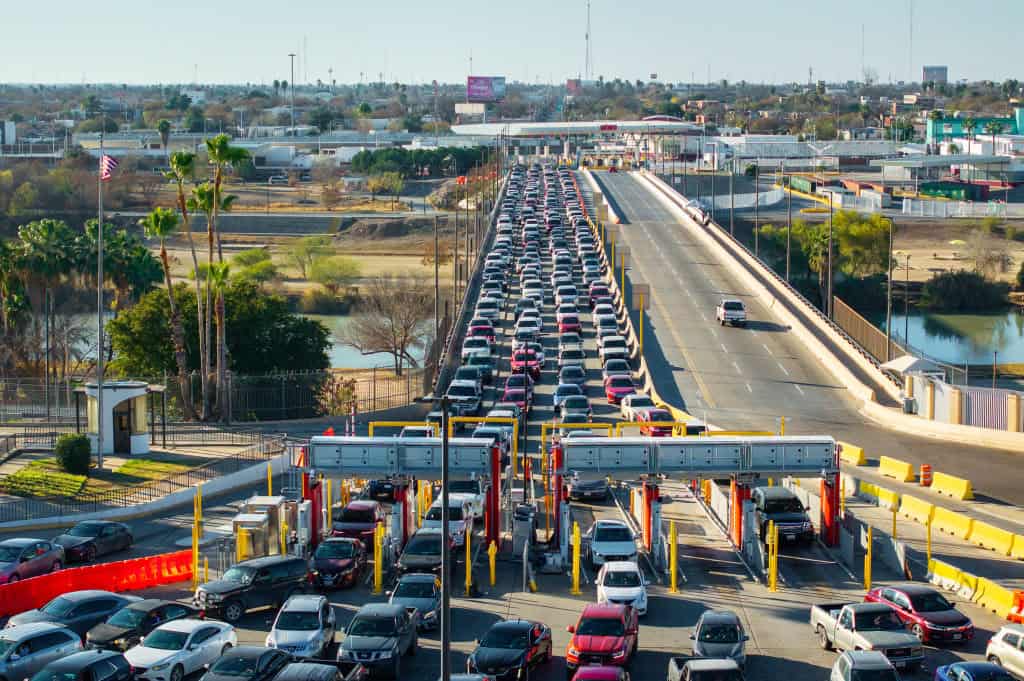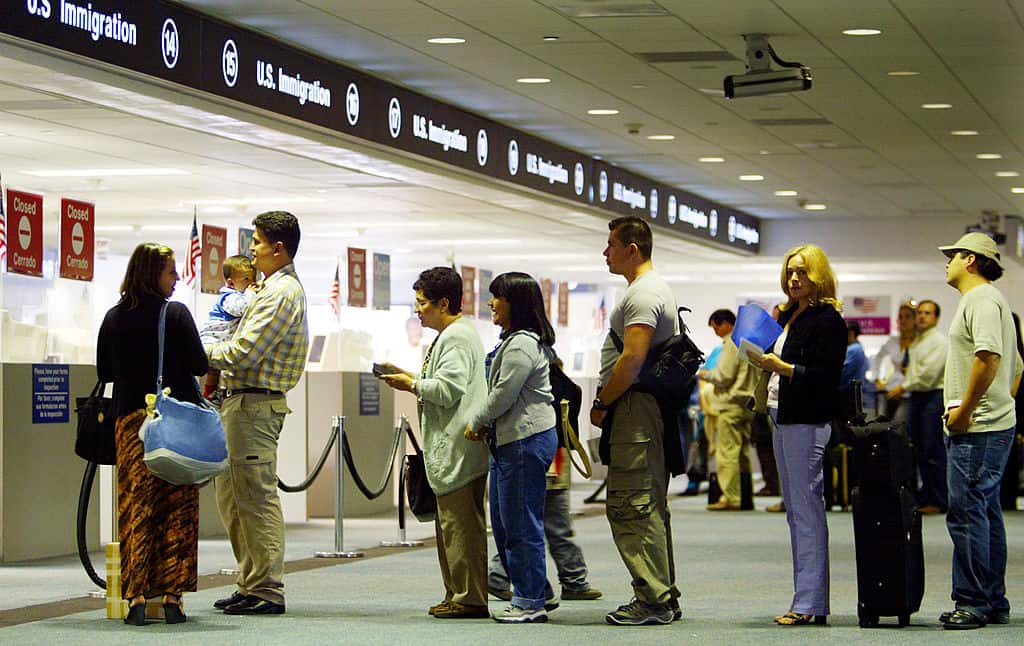White House Announces New Application Fee for H-1B Visas

Last week, President Trump issued a proclamation imposing a new filing fee for H-1B visa petitions.
What’s going on: The Department of Homeland Security will require a new $100,000 fee for H-1B visa applications. The proclamation went into effect at 12:01 a.m. on Sunday, Sept. 21.
- H-1B visas are issued typically for highly skilled foreign workers in high-demand fields and allow them to work in the United States for three years.
- By statute, there are 65,000 H-1B visas available each year, plus an additional 20,000 visas for foreign professionals with advanced degrees from U.S. universities. Each year, the number of applications received from employers far exceeds the number of visas available.
What it means: The White House clarified that current H-1B visa holders are not affected by the fee, which applies only to new H-1B visa applicants. Companies will be expected to remit the $100,000 fee as a one-time payment to accompany their petitions. It will go into effect in the upcoming 2026 lottery cycle.
- Those who already hold H-1B visas who happen to be outside the U.S. will not be charged a fee to reenter. H-1B visa holders can leave and reenter the country as they normally would have prior to the proclamation.
- The proclamation will be in effect for 12 months, though the proclamation states that it could be extended or renewed.
- Commerce Secretary Howard Lutnick emphasized that the new fee would ensure corporations “hire Americans and make sure the people that come into the country are top, top people.”
The NAM says: “Our industry relies on programs like H-1B to expand our workforce, fuel innovation and accelerate investment in AI and advanced manufacturing,” said NAM Vice President of Domestic Policy Jake Kuhns. “With more than 400,000 open jobs across the sector, manufacturers must have access to the talent needed to strengthen manufacturing in the U.S.—a priority of President Trump.”
DOJ Ramps Up Workplace Immigration Enforcement

Federal prosecutors have been ordered to prioritize the prosecution of “immigration-related violations,” according to a recent memo from U.S. Attorney General Pam Bondi to all Justice Department employees.
What’s going on: The memo, sent Feb. 5, tasks U.S. Attorneys’ Offices across the U.S. with using “all available criminal statutes to combat the flood of illegal immigration … and to continue to support the Department of Homeland Security’s immigration and removal initiatives.” The offices are also required to track and report immigration-related cases and convictions.
What it means: Under the new policy, employers that knowingly hire foreign workers who lack work authorization will face heightened risks of criminal prosecution.
- There will also be more criminal investigations into employers found to have committed workplace immigration violations, even unintentional ones.
- Companies that have a history of noncompliance will be prioritized for enforcement actions.
- The federal government will lean on state and local authorities to investigate and pursue immigration-related violations. Those that obstruct investigation efforts (which can include simply failing to comply or cooperate) could face criminal charges.
- Prosecution will not be limited to large companies.
Dive deeper: Read our partner law firm Fisher Phillips’ top five takeaways from the DOJ memo.
Mexico, Canada Tariffs Paused

By deciding to pause the imposition of tariffs he announced last weekend on Mexico and Canada, President Trump shows he’s hearing manufacturers “loud and clear,” the NAM said yesterday.
What’s going on: Two days after signing three separate executive orders under the International Emergency Economic Powers Act to add new levies on goods from Mexico, Canada and China, President Trump announced a one-month pause yesterday on the 25% tariff on Mexican goods and the 25% tariff on Canadian goods, including the 10% levy on energy products.
- President Trump, who had cited illegal immigration and the flow of illicit drugs into the U.S. as the impetus for the new tariffs, said Mexican President Claudia Sheinbaum agreed Monday morning to “immediately supply” 10,000 Mexican National Guard troops to the border.
- The announcement about the tariffs on goods from Canada came following an afternoon phone call between President Trump and Canadian Prime Minister Justin Trudeau.
- The 10% additional tariff applying to products from China went into effect today. In response, China announced retaliatory tariffs on certain goods imported from the U.S., as well as additional restrictions on critical minerals exports to the U.S. (The Wall Street Journal, subscription).
Staying competitive: “This decision by President Trump reflects his swift move to keep his campaign promises, balancing a commitment to aggressive border enforcement with the need to keep manufacturing in the United States competitive,” NAM Executive Vice President Erin Streeter said.
- “The NAM has worked closely with the administration, ensuring that the voices of manufacturers were heard loud and clear. Throughout the weekend, we engaged directly with senior officials, providing key data and real-world industry perspectives. Our efforts helped underscore the risks of broad-based tariffs and the importance of North American supply chains to manufacturing’s success.”
- NAM President and CEO Jay Timmons reinforced President Trump’s and the manufacturing sector’s priorities in interviews Monday with CNBC and ABC, as well as in a statement cited by the Wall Street Journal editorial board.
Certainty needed: For manufacturing in the U.S. to thrive, “we need to bring costs down,” Timmons told ABC. “And if you don’t have that, or you have the uncertainty of what’s coming next, manufacturers are reluctant to invest in new plants and equipment and facilities. They’re reluctant to hire new workers … raise wages or increase benefits. … Once we get all this sorted out, I think it will be good news for manufacturers,” but the sooner that happens, the better, he concluded.
- Timmons also discussed President Trump’s landmark 2020 U.S.–Mexico–Canada Agreement, which he said provided manufacturers with the certainty the sector requires.
- “The certainty that was provided by a negotiated and accepted trade agreement by the three countries enabled manufacturers to make investment decisions,” Timmons told CNBC. “Now we have more uncertainty about what’s ahead … but we assume that there is a rationale for this.”
Key statistics: The USMCA was vital in shifting key imports away from China to North America. According to a new NAM fact sheet:
- Fully one-third of all U.S. manufacturing inputs come from Canada and Mexico;
- Some 70% of what we import from Canada and nearly 60% of imports from Mexico are capital equipment, industrial supplies and automotive parts that go into further manufacturing in the U.S.; and
- The value of U.S. imports of manufacturing materials from North America is now three times greater than the value of materials coming from China.
The bottom line: “We appreciate the administration’s continued willingness to receive our data and manufacturing stories,” Streeter went on. “We will continue working with policymakers to ensure that future decisions support both national security and manufacturing’s success.”
NAM in the news: The NAM’s advocacy received widespread attention in the media, with Fox Business, CNBC, Bloomberg (subscription), CNN, The New York Times (subscription), Punchbowl News and a Wall Street Journal (subscription) article all highlighting its statements on the impact of tariffs on manufacturers.
- Its positions were also mentioned on “Bloomberg Surveillance,” CTV News Channel, MSNBC’s “Inside with Jen Psaki” and MSNBC’s “Morning Joe.”
Trump Acts on Immigration

President Trump’s flurry of executive orders also included major changes to immigration policy.
National emergency: President Trump declared a national emergency at the southern border, aiming to bolster border security and deter illegal entry into the country. Specific actions include:
- Building physical barriers, both temporary and permanent;
- Directing the Department of Homeland Security to deter illegal immigration and detain illegal immigrants until they can be removed swiftly from the country;
- Reinstating the “Remain in Mexico” policy; and
- Terminating the CBP One app, which is used to schedule border appointments and facilitate entry into the U.S.
Forceful intervention: Another EO directs the military to protect the sovereignty, territorial integrity and security of the U.S. and its borders.
- President Trump also defined the situation at the southern border as an “invasion,” effectively suspending the ability of individuals to apply for asylum.
Other actions: President Trump reinstated his 2017 border security EO that withholds federal funds from sanctuary cities while encouraging collaboration between federal and state agencies, steps up deportations and directs U.S. Immigration and Customs Enforcement to hire 10,000 immigration officers. He also restored a 2017 EO providing for “enhanced vetting” of refugees.
- President Trump also issued an EO on birthright citizenship, setting up legal challenges over his administration’s interpretation of the 14th Amendment.
The NAM says: “President Trump is right to make the border a first priority,” said NAM Managing Vice President of Policy Chris Netram. “Control of our borders is a national security imperative that provides certainty about the individuals in our country and ensures the rule of law is upheld.”
- “Even as we secure our borders, we must ensure that America remains a beacon of opportunity and innovation. Manufacturers welcome the opportunity to work with the Trump administration and Congress to fix our broken immigration system. America deserves a modern, well-functioning system for welcoming new people to the United States that helps drive our economy forward, meets our nation’s workforce needs and ensures that the United States remains the most innovative and prosperous country on the planet.”
NAM, Allies: Allow Cross-Border Trade

Manufacturers and other businesses on both sides of the U.S.–Mexico border are feeling the pinch from sudden, intermittent port closures and other government measures being taken to mitigate the ongoing migrant crisis, the NAM and two allied groups told President Biden and Mexican President Andrés Manuel López Obrador this week.
What’s going on: Last December, U.S. Customs and Border Protection temporarily shuttered critical rail ports, including San Diego, California, and El Paso and Eagle Pass, Texas, in an effort to stem migration surges, idling nearly 10,000 rail cars on both sides of the border.
- Last month, the Texas Department of Public Safety renewed safety inspections of vehicles between Texas and Mexico, adding hours to cargo trucks’ border wait times (Freight Waves).
Why it’s important: Port closures and increased vehicle inspections “have significantly increased congestion around ports of entry, caused delays to cross-border trade and harmed productive businesses across industries and their employees,” said NAM President and CEO Jay Timmons, Texas Association of Business President and CEO Glenn Hamer and CONCAMIN President Alejandro Malagón.
- The stoppages “risk making critical supply chains between the United States and Mexico less resilient and dependable.”
What should be done: The U.S. and Mexican governments must commit to creating and abiding by predictable, transparent processes for cross-border trade, the groups urged.
- In addition to stopping the port closures for commercial freight and trucking, “our two countries should strive to enhance trading ties as the importance of nearshoring and friendshoring accelerates. Doing so will make our manufacturing, energy and agricultural sectors more competitive globally.”
U.S. Birthrate Falls

The U.S. fertility rate is at record lows (The Wall Street Journal, subscription).
What’s going on: “The total fertility rate fell to 1.62 births per woman in 2023, a 2% decline from a year earlier, federal data released Thursday showed. It is the lowest rate recorded since the government began tracking it in the 1930s.”
- The data reflect a continuing trend: American women, across ethnic groups, are delaying or foregoing having children.
- In 2023, the number of U.S. births was the lowest in 44 years.
Why it’s happening: “A confluence of factors are at play. American women are having fewer children, later in life. Women are establishing fulfilling careers and have more access to contraception.”
- As a group, they are also increasingly uncertain about their futures “and spending more of their income on homeownership, student debt and child care.”
The details: From 2022 to 2023, birthrates declined more among younger women.
- “Women in their mid-to-late 30s are having children at similar rates to those in their early to mid-20s. Birthrates for women 35–39 fell to 54.7 births per 1,000 women—closer to the rates for women 20–24, which dropped 4% to 55.4 births per 1,000 women in 2023.”
- Birthrates among women in their 40s stayed the same.
Why it’s important: Fewer U.S. births could reshape the economy and “other facets of American life.”
- However, “[a]n influx of people immigrating to the U.S. could offset the impact of lower birthrates on the U.S. population’s size,” said Brady Hamilton, a co-author of the Centers for Disease Control and Prevention report that includes the data findings. “Immigration has risen in recent years, easing labor shortages and expanding the population of big metropolitan areas.”
Read more: For a comprehensive blueprint on U.S. immigration reform, download “A Way Forward,” the NAM’s recommendations to Congress on the subject.
Regulatory Onslaught and Inaction on Key Manufacturing Priorities Weigh on Industry Ahead of State of the Union Address
Nearly 94% of respondents believe federal tax code should promote R&D, capital and equipment expenditures
Washington, D.C. – The National Association of Manufacturers released its Manufacturers’ Outlook Survey for the first quarter of 2024, which reveals that the expiration of federal tax incentives related to R&D, interest deductibility and expensing for capital investments has already caused nearly 40% of respondents to pull back on hiring and investing due to increased taxes.
“Manufacturers’ concerns in this survey should provide a stark warning to both parties ahead of the State of the Union: If you want to continue America’s manufacturing resurgence, focus on constructive policies to strengthen our industry—reinstating key tax provisions, achieving immigration solutions and advancing permitting reform. But if President Biden wants to put his manufacturing legacy at risk, nothing will do that faster than raising taxes on manufacturers or continuing this regulatory onslaught,” said NAM President and CEO Jay Timmons.
The latest data show that two-thirds (65.5%) of manufacturers said that rules coming from the Biden administration will be costly to implement. Additionally, amid the regulatory onslaught, concern about the overall business climate was elevated and not far from levels last seen at the end of 2016.
“President Biden and Sen. Britt will opine on their parties’ respective priorities, many of which manufacturers share. But actions speak louder than words. Congressional inaction and the stream of senseless regulations from the EPA and elsewhere are creating greater uncertainty for businesses, which hurts manufacturers’ ability to create jobs and raise wages. All of this is undermining manufacturers’ confidence and has the potential to drive investment away from the United States,” added Timmons. “Our commitment is to work with anyone who will put policy—policy that supports people—ahead of politics, personality or process.”
Overall, 68.7% of respondents felt either somewhat or very positive about their company’s outlook, edging up slightly from 66.2% in the fourth quarter. It was the sixth straight reading below the historical average of 74.8%.
Key Survey Findings:
- Nearly 94% of respondents say that it is important for the federal tax code to help reduce manufacturers’ costs for conducting R&D, accessing capital via business loans and investing in capital equipment purchases, with 58% saying that it is very important.
- The majority of respondents (72.4%) said that the length and complexity of the current permitting reform process affects their investment decisions in various degrees, with 38.9% suggesting that they were extremely or moderately impacted. In survey responses throughout 2023, manufacturers stated that reform to the current system could allow them to hire more workers, expand their business and increase wages and benefits.
- More than 65% of manufacturers cited the inability to attract and retain employees as their top primary challenge.
- An unfavorable business climate (58.9%), rising health care and insurance costs (58.2%) and weaker domestic economy and sales for manufactured products (53.2%) are also impacting manufacturing optimism.
You can learn more at the NAM’s online tax action center here.
The NAM releases these results to the public each quarter. Further information on the survey is available here.
-NAM-
The National Association of Manufacturers is the largest manufacturing association in the United States, representing small and large manufacturers in every industrial sector and in all 50 states. Manufacturing employs nearly 13 million men and women, contributes $2.85 trillion to the U.S. economy annually and accounts for 53% of private-sector research and development. The NAM is the powerful voice of the manufacturing community and the leading advocate for a policy agenda that helps manufacturers compete in the global economy and create jobs across the United States. For more information about the NAM or to follow us on Twitter and Facebook, please visit www.nam.org.
Immigration Reform and Border Security Critical to Manufacturers’ Success in America
Washington, D.C. – Following the Senate introduction of the Border Act of 2024, National Association of Manufacturers President and CEO Jay Timmons released the following statement:
“For years, manufacturers have called on Congress to fix our broken immigration system, and the need for a solution at the border has only grown more urgent. This bill is neither perfect nor comprehensive, but it is important to take steps to address immigration reform and border security consistent with our plan, ‘A Way Forward.’
“Manufacturers believe the Senate’s legislation clears some critical tests: Does it make us more secure than we are today by tackling the border crisis? Yes. Does it address our ongoing worker shortage through strengthening the visa program? Yes. And does it protect democracy by supporting our allies overseas? Yes.
“Anytime Congress shows progress on sensible policy, it is a positive development for our country. The bipartisan group of Senate leaders deserves great credit for forging a plan on one of the most complicated issues facing our nation, and we appreciate the leadership’s support for this critical work.
“The NAM will work with both chambers and the administration to enact meaningful change on the critical issues of immigration and border security.”
-NAM-
The National Association of Manufacturers is the largest manufacturing association in the United States, representing small and large manufacturers in every industrial sector and in all 50 states. Manufacturing employs nearly 13 million men and women, contributes $2.85 trillion to the U.S. economy annually and accounts for 53% of private-sector research and development. The NAM is the powerful voice of the manufacturing community and the leading advocate for a policy agenda that helps manufacturers compete in the global economy and create jobs across the United States. For more information about the NAM or to follow us on Twitter and Facebook, please visit www.nam.org.
Commerce Updates Chip-Export Restrictions

The Biden administration announced broad updates to restrictions on U.S. exports of advanced computing and semiconductor-making equipment to China, according to Reuters (subscription).
What’s going on: “The measures are designed to prevent China from acquiring the cutting-edge chips needed to develop AI technologies such as large language models, which power applications such as ChatGPT but that U.S. officials say also have military uses that present a national security threat.”
- The updated interim final rules announced on Oct. 17 will go into effect Nov. 17 and will “reinforce the October 7, 2022, controls to restrict [China]’s ability to both purchase and manufacture certain high-end chips critical for military advantage,” according to a press release from the Commerce Department’s Bureau of Industry and Security.
Why it matters: “These controls were strategically crafted to address, among other concerns, [China]’s efforts to obtain semiconductor manufacturing equipment essential to producing advanced integrated circuits needed for the next generation of advanced weapon systems” and other technologies that “present U.S. national security concerns,” according to the BIS.
- In an effort to control a wider range of chips, Tuesday’s rules will focus on computing power only and will require companies to notify the U.S. government when they sell chips that come in just under restriction limits.
“Chiplets”: The rules also seek to address “chiplets,” in which small portions of a chip are spliced to make a full chip.
- “Analysts had expressed concern that Chinese firms could use such technology to acquire chiplets that stayed within the legal limits but that could later be assembled in secret into a larger chip that would break the rules,” according to Reuters.
The last word: “By imposing stringent license requirements, we ensure that those seeking to obtain powerful advanced chips and chip manufacturing equipment will not use these technologies to undermine U.S. national security,” said Assistant Secretary of Commerce for Export Administration Thea D. Rozman Kendler.
DOJ, ACLU Reach Settlement on Separated Migrant Families

The Justice Department has reached an agreement with the American Civil Liberties Union that would give benefits to thousands of migrant families separated at the border under the previous administration’s policies, according to ABC News.
What’s going on: “Under the proposed agreement, the Justice Department says, new standards would be established to limit migrant family separations in the future. The settlement would prohibit separations unless there are concerns regarding the wellness of the migrant child, national security issues, medical emergencies or in the case of criminal warrants.”
- The deal—on which a federal judge must still sign off—would also cover any medical costs incurred because of the separations.
- If approved, it would stay in effect for six years.
Why it’s important: “[U]nder the settlement, more than 3,900 children and their families would be eligible for temporary relief from future deportation for up to three years, with a chance to renew. Members of those families would also be granted work authorizations.”
- More than 75% of the originally identified families that were separated have either been reunited or given the information they need to reunite, according to a Biden administration official.
- “The agreement further expands the number of families that will be eligible for humanitarian parole and reunification, meaning that the ACLU and other organizations will be receiving information on separated families that was previously unknown,” according to ABC News.
Previous policy: A policy in place for four months in 2018 “mandated prosecutions for all suspected illegal border crossings, which led to parents being deported while their children stayed in U.S. custody or were placed in foster care.”
The last word: “The NAM has long called for policy that explicitly prohibits the separation of minor children from their parents, which is what we lay out in ‘A Way Forward,’ our immigration-policy document,” said NAM Director of Domestic Policy Julia Bogue.
